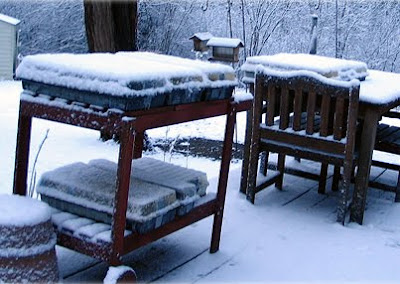This year was my third (fourth?) winter sowing season, and the first and only time I've ever lost seedlings. Temperature fluctuations are normal in winter in Michigan and are not a big threat to winter seed sowing. The seeds will only sprout after longer, warmer temperatures, each seed on its own natural schedule. A few days of unseasonably warm temperatures, say in February, won't trick a seed into sprouting only to be decimated through the rest of winter when temperatures sink back to frigid.
It was mild back in late December when I set out my first tray flats. Here condensation levels are perfect for a newly sown, set-out tray on December 23, 2006.
A month later, things had gotten cold and snowy. That's no problem at all, because the seeds are happily dormant in their long winter's nap. The same tray on January 24, 2007, is okey dokey!
By mid March, I had sown a few more flats. The snow had melted temporarily, but it was still cold. Yep. It was all good on March 12.
Three days later, on March 15, it had snowed again and I had set out more flats. Yep. Everything on track. Snow, melting, snow. Yep, that's Michigan. Yawn.
Another three days later, on March 18, the snow was gone again, but it was still cold and the lids of the seed trays had cool frost patterns.
By early April, it had gotten fairly warm for many days in a row and a few eager seedlings pushed their heads above the soil. Hooray! Welcome, harbingers of spring. (There was much rejoicing.) On April 6, temps dropped and it snowed again. Not a big deal. Sprouted seedlings, protected in their dome, can handle a few days of frost. Look, aren't they cute there in the frosted little greenhouse?
Only it stayed well below freezing for many days, enough that for the first time ever, I lost many of my seedlings (peas, beans, moon flowers, and morning glories in particular). I didn't have the heart to photograph their collapsed little corpses.
Now, I probably would have been able to save the seedlings by bringing them into my shed (or a garage, if I had one). Frankly, it probably would have helped just to move them under my deck or under the patio table. (Taking them indoors where it would have been way too tropical in comparison would have been just as bad. Don't try that at home!) But I truly had so much faith in the process, it never actually occurred to me they might actually die, and I wasn't entirely aware of how many frost days we ended up having.
I'm sharing this loss not as a way to discourage anyone from winter seed sowing, but to contrast how well it actually DOES work under normal fluctuations. The lesson I carry with me is to move seedlings to a more sheltered, but still cold, location after, say, two days of extreme cold following a really long period of extreme warmth.
So in late April, I did what gardeners must have been doing for centuries. Dried my tears and reseeded! I used the same WSing containers (and even the same soil, which some people might not recommend, and if teaching a class, I might advise against it myself, but in the time constraints of my real life, it was easier to keep the soil already in place than empty and refill) and kept them covered only at night until it got warm enough not to require even that level of protection. I thought of it as "spring seed sowing" and it worked just fine. Here are those seedlings on May 31 ready to be planted. (Had the winter-sown seedlings survived, they could have been planted out a good month earlier.)








Hi Monica, I clicked on Winter Seed Sowing in your comments to Lucy. I really got a lot out of this post. It looks fairly easy to do. I suppose there's still time for me to try it...although the weather is beginning to warm up a bit. It's been 30's-40's at night and 40's-60's in the day. Cold/Warm...
ReplyDeleteI am considering doing this, but I have to go buy all the containers. I saw a bunch of them at Lowes. I'll let you know what I end up doing:)